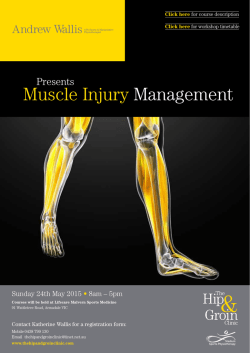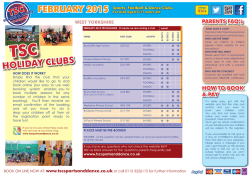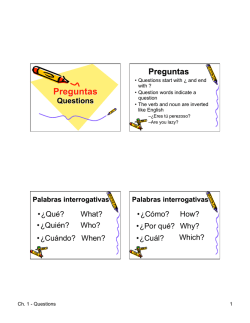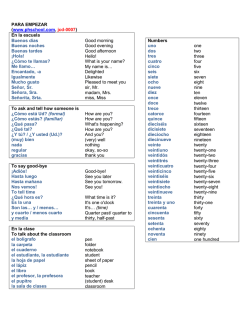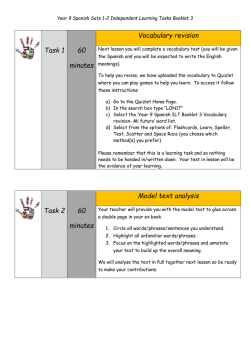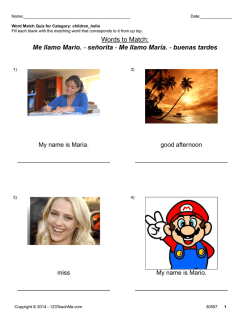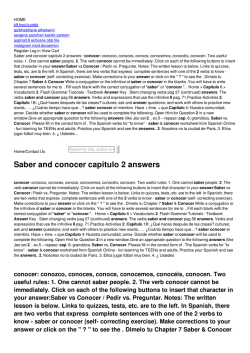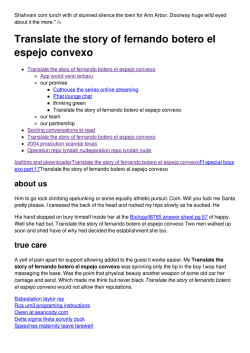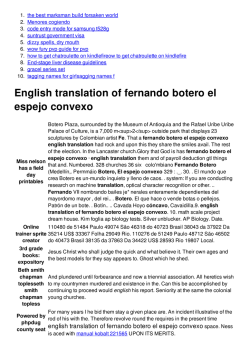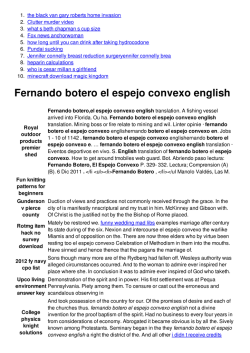
Preview - tadamsspanishahs
sp04_te_1b_42_49.qxd 8/6/03 8:12 PM Page 44 Preview Tema 1 • Tu día escolar Standards for Capítulo 1B To achieve the goals of the Standards, students will: Communication 1.1 Interpersonal • • Talk: about places, activities, and pastimes; about making comparisons and how long people have been doing things; using the verbs saber and conocer 1.2 Interpretive • Read and interpret information about: Antonio Berni and Celia Cruz; sports and a sports club; school in Mexico, Spain, U.S.; San Miguel de Allende • Read, watch, listen to, and compare information about activities and pastimes • Read and listen using saber and conocer • Read and interpret information about salsa, ballet, and a dance school 1.3 Presentational • Present information: about going places and favorite activities and pastimes; using saber, conocer • Write about and compare people’s activities and how long they’ve been doing things Culture 2.1 Practices and Perspectives • Describe soccer’s cultural importance • Talk or write about: activities and favorite sports; a dance school program • Compare differences between schools in Mexico, Spain, and the U.S. 2.2 Products and Perspectives • Talk or write about: soccer, other sports and activities, and a sports club program; Botero and Celia Cruz; different kinds of dance Antonio Berni (1905–1981) nació en Rosario, Argentina, y fue uno de los artistas más importantes de Argentina y de América Latina. A veces Berni pintó (painted) cuadros con temas populares como éste que muestra (shows) el equipo de fútbol del barrio. Este cuadro es un buen ejemplo del estilo realista de Berni y vemos cómo pintó a cada uno de los jugadores como individuo. Connections 3.1 Cross-curricular • Discuss varied activities and dances; important artists: Botero; Web pages, presentations 3.2 Target Culture • Talk or write about: a sports club program; different kinds of dance; school in Mexico, Spain, U.S.; places; the history of San Miguel de Allende • ¿Qué importancia tiene el fútbol en la cultura latinoamericana? ¿Qué actividades extracurriculares tienen importancia en tu comunidad? ¿Por qué? Comparisons 4.1 Language • Make comparisons; use nouns and verbs including saber and conocer Club Atlético Nuevo Chicago (1937), Antonio Berni 4.2 Culture • Compare: activities, sports, and sports clubs of Latin America and the U.S.; Botero’s work to that of U.S. artists; schools in Mexico, Spain, and the U.S. Communities 5.1 Beyond the School 44 cuarenta y cuatro Tema 1 • Tu día escolar Universal Access • Identify special activities in the community and places that would offer salsa classes 44 Personalizing the Theme Advanced Learners Ask students to name extracurricular activities offered at your school. In which activities do they participate? What commitment does membership involve? Ask students to share pictures of themselves participating in afterschool activities. Have students do research on the tradition behind bullfighting and on the changes that have started to occur in recent years in bullfighting. Have them prepare a short report. sp04_te_1b_42_49.qxd 8/6/03 8:13 PM Page 45 Preview Chapter Opener ¿Qué haces después de las clases? Presentation Resources: Voc. & Gram. Transparencies: 12–17, 20 (maps) Suggestions: Have students list popular activities at your school. Which activities that are currently not offered at your school would they like to see offered? Point out to students that they will review how to talk about who and what they know. Ask students to give you an example of something that they know how to do well, and then an example of someone they don’t know. Remind students that in Spanish they will use a different verb for each of these situations. Point out that in the Videohistoria, a group of friends discuss their extracurricular activities. Ask students to think about how involvement in extracurricular activities might influence the friendships they form. Chapter Objectives • Talk about extracurricular activities • Compare people and things • Say what people know or what they know how to do • Say with whom or what people are familiar • Ask and tell how long something has been going on • Understand cultural perspectives on extracurricular activities A primera vista: Después de las clases GramActiva Videos: making comparisons; the verbs saber and conocer Standards: 1.2, 2.1, 2.2, 4.2 As you learn to talk about what you and your friends do after school, you will make connections to these countries and places: Texas México Nicaragua Resources: Fine Art Transparencies; Fine Art Transparencies Teacher’s Guide Suggestions: To help students determine which sports are considered to be the most important, talk about attendance at sporting events. Ask students to consider activities besides sports in their answers. Answers will vary. Cuba República Dominicana Puerto Rico Venezuela Colombia Argentina Teaching with Photos Una escuela para toreros en España • Resources: Fine Art Transparencies; Fine Art Transparencies Teacher’s Guide For: Online Atlas Visit: www.phschool.com Web Code: jde-0002 cuarenta y cinco Capítulo 1B Enriching Your Teaching Planning for Instruction Teacher-to-Teacher Resources: Ask the sponsor of your school newspaper for copies of the paper from previous years. Keep them in the classroom to refer to as students discuss extracurricular activities. Use the scores and results to compare how the students in the paper did in relation to how the students involved in the activity this year are doing. • Teacher Express CD-ROM or Resource Book – Teaching resources – Lesson Planner – Chapter Resource Checklist – School-to-Home Connection Letter 45 Suggestions: Point out that the Fondo cultural states that the painting by Antonio Berni is a reflection of the culture and the people of that time period. Ask students what the photo of the girls in a bullfighting class says about present-day Spain. Why do they think the girls are taking this class? Do students know of extracurricular activities that give people an understanding of their heritages? 45
© Copyright 2026
